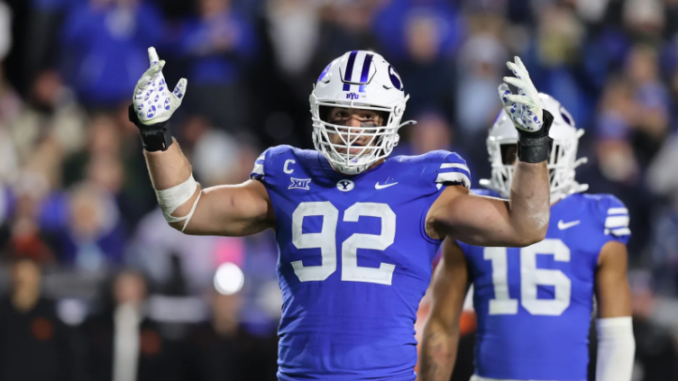
Scouting Summary
BYU Cougars defensive lineman Tyler Batty is an imposing force on the line. He ought to be viewed as a high-floor player at the NFL level. He possesses the build and strength to establish conditions when required to shift the line of scrimmage.
As a 4-year starter, Batty’s instincts are an advantageous trait that may help him transition to the NFL more smoothly than others. Batty is an experienced player due to the additional eligibility granted by the COVID-19 pandemic and a two-year mission served while at BYU. This makes him a physically developed defender who should attract gap control fronts and teams that can see Batty positioned above offensive tackles in his stance.
He has shown strong production in pressuring the quarterback over the last few seasons, but Batty’s greatest strengths will be evident on early downs as a professional.
2025 NFL Combine Results
TBD
Advantages
Exceptional instincts and awareness of running schemes and creating blocks at the point of contact.
Strong finisher as a tackler who can serve as a tone-setting presence along the line in the running game.
The anchor securing the point of attack is strong and provides him with versatility in schemes during early downs.
Cons
Lacks the initial explosiveness or efficiency necessary to be a significant threat when rushing the passer from the edge.
A tall build presents certain constraints regarding flexibility and maneuvering in narrow areas or sharp turns.
The range of pass rush techniques is restricted by agility and burst ability.
Context
Tyler Batty competed in high school football at Payson High School in Payson, Utah. At that location, he was rated as a 3-star recruit (247 Sports) and had offers from Utah, Utah State, and Air Force before joining BYU as part of the 2017 recruiting class. As part of Batty’s obligations to the university, he completed a full-time mission in Malaga and Madrid, Spain, between 2017 and 2019 before starting his football career in the shortened 2020 season due to COVID-19.
By 2021, Batty had established himself as a starter for the Cougars program and gradually evolved into a significant contributor in every aspect throughout his four years as a starter. Batty, who was born on May 2, 2000, will enter the upcoming season as a rookie at 25 years old, thanks to his mission with the Church of Jesus Christ of Latter-day Saints and an additional year of eligibility from the pandemic.
Story of the Measurements
Batty is a remarkable physical presence who stands out along the defensive line. He’s lengthy, robust, and strong all over his build. Due to his strong hands, required length, and capacity to maintain the point of attack, Batty resembles a gap-control defender at the NFL level.
His pass-rush performance at BYU is significant, but it’s the running plays where Batty truly stands out on film. It’s simple to recognize how swiftly he identifies blocks, how effectively he predicts the movements of the ball carrier, and how rapidly he can move sideways to respond to and confront the ball.
If positioned over a tight end in the running game, anticipate great success. Batty dismantles skill players trying to block him and continually pushes back the line of attack, prompting ball carriers to make early cuts. Against offensive tackles, Batty demonstrates effective punch timing, hand positioning, and shock through his body to disrupt blockers and make impacts.
He swiftly stretches and opens his chest — essential, considering his inherent lack of leverage due to his height. He is typically polished and exact in these aspects, which is anticipated considering his development as a 24-year-old fifth-year senior in 2024.
His side-to-side movement can cover multiple gaps, but it would be more accurately termed fluid rather than dynamic. Batty may not provide much quick twitch or explosiveness in his movements — a consequence of his size, characterized by a tall stature and elevated hips.
Considering that, he is an athlete who excels in straightforward scenarios — both while running the ball and as a receiver. His trademarks are stacking the point of attack and trying to overpower to break down the edge. You observe him utilizing a euro-chop counter to penetrate inside against tackles, which are positioned too deep, allowing him to capitalize on these circumstances due to the shallower angles he employs to surge toward the quarterback. Alternatively, he aims to guide you back into the pocket, and he is definitely capable of achieving that.
His assortment of rush moves is limited, though. Batty seems like a player who might be more effective charging indoors and providing a more dynamic threat for an outside rush. Batty doesn’t quite time his initial step effectively from the wide-angled 2-point stance that BYU has him utilizing. Even if he were to, he just lacks the explosiveness to surpass tackles with quickness.
That absence of spring affects the running game if teams attempt to option off him and compel him to make rapid, instinctive choices on the edge. His capacity to quickly maneuver and reflect smaller players in open areas is limited because of his elevated center of gravity and insufficient dynamic flexibility in the lower body.
Perfect Program Match, Position
Batty has several paths to a successful career in the NFL, yet I would be excited to see him gain weight to function as a reduced, odd front end who lines up over tackles and in a 4i position.
In that scenario, his rushing instincts could provide significant value without diminishing the overall potential of the pass-rush unit. Batty can serve as an NFL starter in this capacity; if he maintains a slimmer weight, he’s expected to be a rotational defender on early downs.

Leave a Reply